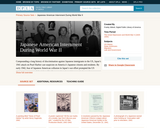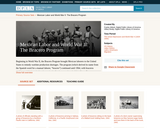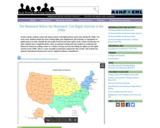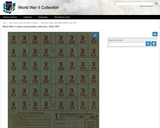
A video [0:40] of James Wright telling of his experience as he witnessed the bombing of Pearl Harbor.
- Subject:
- Social Studies
- Material Type:
- Audio/Video
- Provider:
- PBS LearningMedia
- Date Added:
- 12/01/2022

A video [0:40] of James Wright telling of his experience as he witnessed the bombing of Pearl Harbor.

Outlines Japanese history from 1915-1945. There are also many links to other information about Japan.

This collection uses primary sources to explore Japanese American internment during World War II. Digital Public Library of America Primary Source Sets are designed to help students develop their critical thinking skills and draw diverse material from libraries, archives, and museums across the United States. Each set includes an overview, ten to fifteen primary sources, links to related resources, and a teaching guide. These sets were created and reviewed by the teachers on the DPLA's Education Advisory Committee.

Essay describing how many Jewish people in Germany did not initially believe reports of Jewish extermination due to Nazi control of the press.

This is the account of Nikolai G. Kuznetsov on the end of the war. He was the Admiral of the Fleet of the Soviet Union, and a participant in the Yalta Conference.
![Leaving Things Behind [PDF]](https://openspace.infohio.org/static/newdesign/images/materials/default-thumbnail-index.png)
This resource provides information about Japanese-Americans who were forced to relocate to interment camps during World War II.

After students have read a book about the Holocaust, such as "The Diary of Anne Frank" or "Night" by Elie Wiesel, students will view "Life is Beautiful" and complete discussion questions to challenge their ability to analyze literature using film.

Spark the engagement of English-language learners or reluctant readers with the graphic novel "Maus". The visual information provided by the genre serves as a support for reading and critical engagement.

This collection uses primary sources to explore the Bracero Program. Digital Public Library of America Primary Source Sets are designed to help students develop their critical thinking skills and draw diverse material from libraries, archives, and museums across the United States. Each set includes an overview, ten to fifteen primary sources, links to related resources, and a teaching guide. These sets were created and reviewed by the teachers on the DPLA's Education Advisory Committee.

In this activity, students read cards about various civil rights protests and events during the 1940s. For each event, students match the issue (voting rights, fair employment, fair housing, or segregation in public places) at stake, identify the key people involved and what region of the country it took place in. After students have completed all the cards, an optional writing task asks students to synthesize the historical content by writing a letter to a relative serving overseas describing the efforts of civil rights activists in the 1940s. There is some assembly of materials required for this activity. This activity has optional Smartboard elements but can be completed without a Smartboard.

In this video [4:03] excerpted from Poetry in America, ponder W.H. Auden's World War II era reflections on suffering in "Musee des Beaux Arts" with Ambassador to the United Nations Samantha Power, with journalist and ethicist David Brooks, with poet, professor, and painter Peter Sacks, and with host Elisa New. How are ordinary people to regard, and respond to, suffering they have not caused? Who can help us find the way? The statesman, the journalist, the poet, the painter?

The companion website to the documentary about German U-boats and the loss of the U-869 in particular. A video clip [1:31], interactive tours of the submarine, and other primary sources are included.

Investigate the history of military medicine from the Civil War to the Iraq War, and interpret archival photographs shot on and off the battlefield.

This resource provides data about the physical destruction of Nagasaki, the medical aspect, and survivor stories.

Learn about Wyoming's Native American Veterans as three United States military veterans tell their stories. Students will watch a video that shows interviews with Native American Indian Veterans from the Wind River Reservation who served during the Korean and Vietnam Wars. [27:09] Support materials are provided.

World War II ration memorabilia collection, 1942-1947.
The Office of Price Administration and Civilian Supply was established by Presidential Executive Order 8734 on April 11, 1941, in an effort to control inflation. The civilian supply function of the agency was transferred to the Office of Production Management in August of 1941 and the name was shortened to the Office of Price Administration (OPA). The Emergency Price Control Act (January 30, 1942) established the purposes of the agency as follows: to stabilize prices and rents and prevent unwarranted increases in them; to prevent profiteering, hoarding and speculation; to assure that defense appropriations were not dissipated by excessive prices; to protect those with fixed incomes from undue impairment of their living standards; to assist in securing adequate production; and to prevent a post-emergency collapse of values." The OPA fixed price ceilings on all commodities except farm products and controlled rents in defense areas. The first rationing program, for automobile tires, was initiated December 27, 1941. There were two types of rationing programs. The first was a certificate program, where an applicant had to meet eligibility standards and show need to a local ration board before receiving a certificate permitting purchase of the rationed item. This type of program was applied to ties, automobiles, typewriters, bicycles, rubber footwear and stoves. The second program was a coupon or stamp type for which all civilians were eligible. These programs were administered through local banks and covered foods, fuel oil, gasoline and shoes. Rationing continued throughout World War II and by the end of November 1945 only the sugar and rubber tire rationing programs remained. Tire rationing ceased on December 31, 1945. Sugar rationing continued until June 11, 1947. The Office of Price Administration was dissolved April 1, 1947.

A lengthy essay on Robert Capa and one of his early controversial photos. Includes a great timeline of his life as well as video footage from the PBS documentary of Capa's life.

Captivating video program detailing the experiences of soldiers who participated in the Normandy invasion in 1944. Streaming video and transcripts available.

It was 1943, and the British were retaliating. Here is the story of the famous Lancaster bomber and the brave British pilots that tried to stop Nazi Germany.

Online home of the PBS documentary "The Perilous Fight" provides access to an eclectic array of color photographs and films of World War II at home and abroad. Overviews, contextual clues, maps, letters, and similar resources can be found to complement the visuals, which include scenes of battlefields, the war's psychological toll, the home front, and the roles of women and minorities.